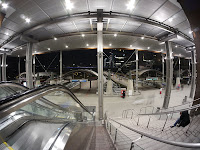But first, let's compare the specs:
Lens | Focal length | Diagonal field of view |
| Samyang 7.5mm f/3.5 fisheye lens | 7.5mm | 180° |
| Lumix G 7-14mm f/4 | 7mm | 114° |
| Olympus 9-18mm f/4-5.6 | 9mm | 100° |
As is apparent from this table, the fisheye lens has a vastly wider diagonal field of view. However, we also know that the fisheye lens has a more compresses field of view the further we get from the centre. Hence, not all of the 180° diagonal field of view can be used when defishing the image.
This can be illustrated by looking at the defishing process. Here are the same images taken with the Samyang 7.5mm fisheye lens, defished, and taken with the Olympus 9-18mm lens at 9mm:
Original fisheye image
|
Defished, not cropped
|
Defished and cropped
|
Olympus 9-18mm @ 9mm
|
The defishing process was done with Hugin, and is described in this article. In this example, I used the "orthographic" lens type, rather than the "fisheye" lens type.
We clearly see that a lot of the fisheye corner image is lost in the transformation process.
Letting the Hugin program calculate the optimal resolution yields a defished and cropped image of 11385 times 4750 pixels. This reflects the true resolution only in the centre of the image, while the resolution is less the further from the centre one gets.
Hence, to compare the wideness of the lenses, it is better to look at the horizontal and vertical field of view:
Lens | Focal length | Horizontal field of view | Vertical field of view | Diagonal field of view | Aspect ratio |
| Samyang 7.5mm f/3.5 fisheye lens | 7.5mm | 132° | 86° | 180° | 4/3=1.33 |
| Samyang 7.5mm f/3.5 fisheye lens defished | 7.5mm | 132° | 86° | 135° | 2.40 |
| Lumix G 7-14mm f/4 | 7mm | 102° | 85° | 114° | 4/3=1.33 |
| Olympus 9-18mm f/4-5.6 | 9mm | 87° | 71° | 100° | 4/3=1.33 |
When given the diagonal field of view, the horizontal field of view can be calculated as:
2*DEGREES(ATAN(TAN(RADIANS(114/2))*COS(ATAN(3/4))))
with the diagonal field of view being 114° in the example formula above.
From the table, we can see that the fisheye lens loses a lot of diagonal field of view when defishing. This is not surprising, since the image must be stretched into the corners. The image also loses resolution in the corners due to this.
The Panasonic Lumix G 7-14mm f/4 is a very wide lens, and it is also very expensive. But using a fisheye lens, we get a resulting defished image which is still far wider in terms of horizontal field of view, and only marginally wider horizontally. This can be further illustrated by showing what crops I would have gotten if I used the two ultra wide zooms to take the same picture:
However, the flip side of the coin is of course that due to stretching out the image into the corners, the resolution suffers. Here is a 100% crop from both the original and defished images from the corner:
If I had used the Lumix G 7-14mm lens at 7mm, this would have been in the extreme corner of the image frame. Now, I don't have this lens, but I think it would have achieved somewhat better sharpness than the defished example above.
Conclusion
When defishing images from the Samyang 7.5mm f/3.5 fisheye lens, the resulting image becomes much wider than that from the widest rectilinear lens for the Micro Four Thirds system, the Lumix G 7-14mm f/4. However, you also lose some resolution in the corners.
Note: After having published this article, I have take actual comparison images using the Lumix G 7-14mm f/4 ultra wide lens and the Samyang 7.5mm f/3.5 fisheye lens.






Nice.
ReplyDeleteWhat's the resolution of the image after being defished and cropped?
It would also be nice to see some full size defished+cropped comparisons between the Samyang and the other lenses to see how it would work as a cheaper wide-angle alternative.
The resolution is a staggering 11385 x 4750 pixels. However, please note that this does not reflect the true resolution, except in the middle of the frame.
ReplyDeleteI have been surfing online more than three hours today, yet I never found any interesting article like yours. Its pretty worth enough for me. In my opinion, if all webmasters and bloggers made good content as you did, the internet will be much more useful than ever before.
ReplyDeletecolleges with photography majors
Glorious data here. This interesting post made me smile. Possibly should you throw in a few pictures it would make the entire thing extra interesting. Anyway, in my language, there usually are not much good supply like this.
ReplyDeleteBest of luck
Bruce Bent II